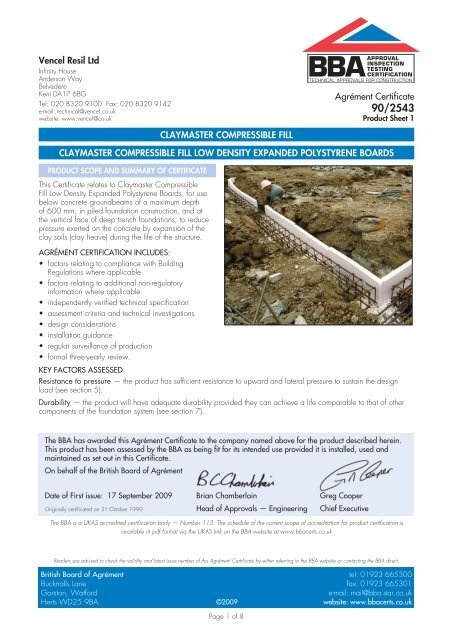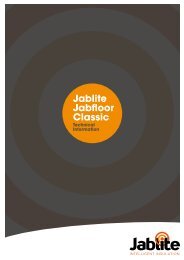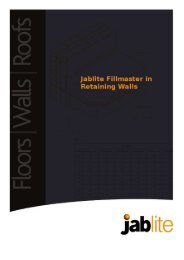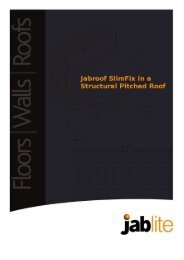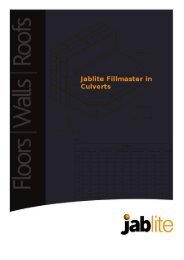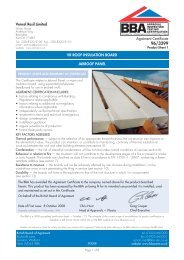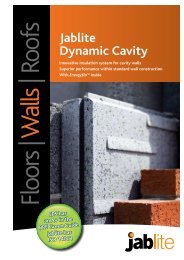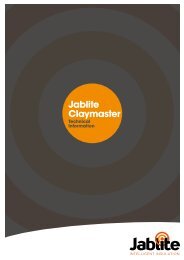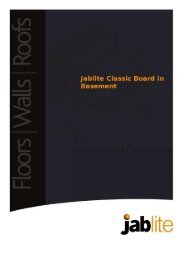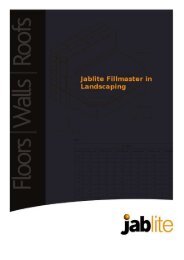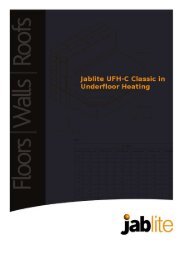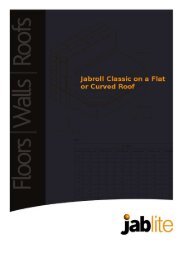Download BBA Certificate - Jablite
Download BBA Certificate - Jablite
Download BBA Certificate - Jablite
Create successful ePaper yourself
Turn your PDF publications into a flip-book with our unique Google optimized e-Paper software.
Vencel Resil Ltd<br />
Infinity House<br />
Anderson Way<br />
Belvedere<br />
Kent DA17 6BG<br />
Tel: 020 8320 9100 Fax: 020 8320 9142<br />
e-mail: technical@vencel.co.uk<br />
website: www.vencel@co.uk<br />
APPROVAL<br />
INSPECTION<br />
TESTING<br />
CERTIFICATION<br />
TECHNICAL APPROVALS FOR CONSTRUCTION<br />
Agrément <strong>Certificate</strong><br />
90/2543<br />
Product Sheet 1<br />
CLAYMASTER COMPRESSIBLE FILL<br />
CLAYMASTER COMPRESSIBLE FILL LOW DENSITY EXPANDED POLYSTYRENE BOARDS<br />
PRODUCT SCOPE AND SUMMARY OF CERTIFICATE<br />
This <strong>Certificate</strong> relates to Claymaster Compressible<br />
Fill Low Density Expanded Polystyrene Boards, for use<br />
below concrete groundbeams of a maximum depth<br />
of 600 mm, in piled foundation construction, and at<br />
the vertical face of deep trench foundations, to reduce<br />
pressure exerted on the concrete by expansion of the<br />
clay soils (clay heave) during the life of the structure.<br />
AGRÉMENT CERTIFICATION INCLUDES:<br />
• factors relating to compliance with Building<br />
Regulations where applicable<br />
• factors relating to additional non-regulatory<br />
information where applicable<br />
• independently verified technical specification<br />
• assessment criteria and technical investigations<br />
• design considerations<br />
• installation guidance<br />
• regular surveillance of production<br />
• formal three-yearly review.<br />
KEY FACTORS ASSESSED<br />
Resistance to pressure — the product has sufficient resistance to upward and lateral pressure to sustain the design<br />
load (see section 5).<br />
Durability — the product will have adequate durability provided they can achieve a life comparable to that of other<br />
components of the foundation system (see section 7).<br />
The <strong>BBA</strong> has awarded this Agrément <strong>Certificate</strong> to the company named above for the product described herein.<br />
This product has been assessed by the <strong>BBA</strong> as being fit for its intended use provided it is installed, used and<br />
maintained as set out in this <strong>Certificate</strong>.<br />
On behalf of the British Board of Agrément<br />
Date of First issue: 17 September 2009 Brian Chamberlain Greg Cooper<br />
Originally certificated on 31 October 1990 Head of Approvals — Engineering Chief Executive<br />
The <strong>BBA</strong> is a UKAS accredited certification body — Number 113. The schedule of the current scope of accreditation for product certification is<br />
available in pdf format via the UKAS link on the <strong>BBA</strong> website at www.bbacerts.co.uk<br />
Readers are advised to check the validity and latest issue number of this Agrément <strong>Certificate</strong> by either referring to the <strong>BBA</strong> website or contacting the <strong>BBA</strong> direct.<br />
British Board of Agrément tel: 01923 665300<br />
Bucknalls Lane fax: 01923 665301<br />
Garston, Watford<br />
e-mail: mail@bba.star.co.uk<br />
Herts WD25 9BA<br />
©2009<br />
website: www.bbacerts.co.uk<br />
Page 1 of 8
Regulations<br />
In the opinion of the <strong>BBA</strong>, Claymaster Compressible Fill Low Density Expanded Polystyrene Boards, if used in<br />
accordance with the provisions of this <strong>Certificate</strong>, will meet or contribute to meeting the relevant requirements of the<br />
following Building Regulations:<br />
The Building Regulations 2000 (as amended) (England and Wales)<br />
Requirement: A2<br />
Comment:<br />
Requirement: Regulation 7<br />
Comment:<br />
Ground movement<br />
The fill prevents expansion of clay soils impairing the stability of the building. See sections 5.1 and 5.2 of<br />
this <strong>Certificate</strong>.<br />
Materials and workmanship<br />
The product is acceptable. See section 7 and the Installation part of this <strong>Certificate</strong>.<br />
The Building (Scotland) Regulations 2004 (as amended)<br />
Regulation: 8(1) Fitness and durability of materials and workmanship<br />
Comment:<br />
The use of the product satisfies the requirements of this Regulation. See section 7 and the Installation part<br />
of this <strong>Certificate</strong>.<br />
Regulation: 9 Building Standards — construction<br />
Standard: 1.1 Structure<br />
Comment:<br />
The fill contributes to meeting the relevant requirements of this Standard. See sections 5.1 and 5.2 of this<br />
<strong>Certificate</strong>.<br />
The Building Regulations (Northern Ireland) 2000 (as amended)<br />
Regulation: B2 Fitness of materials and workmanship<br />
Comment:<br />
The product is acceptable. See section 7 and the Installation part of this <strong>Certificate</strong>.<br />
Regulation: D1 Stability<br />
Comment:<br />
The fill contributes to meeting the relevant requirements of this Regulation. See sections 5.1 and 5.2 of this<br />
<strong>Certificate</strong>.<br />
Construction (Design and Management) Regulations 2007<br />
Construction (Design and Management) Regulations (Northern Ireland) 2007<br />
Information in this <strong>Certificate</strong> may assist the client, CDM co-ordinator, designer and contractors to address their<br />
obligations under these Regulations.<br />
See section: 2 Delivery and site handling (2.2 and 2.3).<br />
Non-regulatory Information<br />
NHBC Standards 2008<br />
NHBC accepts the use of Claymaster Compressible Fill Low Density Expanded Polystyrene Boards, when installed and<br />
used in accordance with this <strong>Certificate</strong>, in relation to NHBC Standards, Chapter 4 Foundations, Sub-sections 4.2<br />
Building near trees; 4.4 Strip and trench fill foundations and 4.5 Raft, pile, pier and beam foundations.<br />
Zurich Building Guarantee Technical Manual 2007<br />
In the opinion of the <strong>BBA</strong>, Claymaster Compressible Fill Low Density Expanded Polystyrene Boards, when installed<br />
and used in accordance with this <strong>Certificate</strong>, satisfies the requirements of the Zurich Building Guarantee Technical<br />
Manual, Section Substructure, Sub-section Foundations.<br />
General<br />
This <strong>Certificate</strong> relates to Claymaster Compressible Fill Low Density Expanded Polystyrene Boards for use below<br />
concrete groundbeams of a maximum depth of 600 mm, in piled foundation constructions, and at the vertifical face<br />
of deep trench foundations to reduce the pressure exerted on the concrete by expansion of the clay soils (clay heave)<br />
during the life of the structure.<br />
It is essential that the correct minimum thickness is calculated from the expected expansion in accordance with sections<br />
3.3 and 3.4 of this <strong>Certificate</strong>, and the product is installed in accordance with BS 8000 -1 : 1989, BS 8000-2.2 :<br />
1990, BS 8004 : 1986 and the Installation part of this <strong>Certificate</strong>, and that storage and handling is in accordance<br />
with BS 6203 : 2003.<br />
Page 2 of 8
Technical Specification<br />
1 Description<br />
1.1 Claymaster Compressible Fill Low Density Expanded Polystyrene Boards consists of low-density expanded<br />
polystyrene boards to BS 3837-1 : 2004, coloured pink.<br />
1.2 The boards are available in the standard sizes shown in Table 1.<br />
Table 1<br />
Board sizes (mm)<br />
Thickness Length (1) Width (1)<br />
50 2400 600 or 1200<br />
75 2400 600 or 1200<br />
100 2400 600 or 1200<br />
150 2400 600 or 1200<br />
200 2400 600 or 1200<br />
(1) Non-standard sizes are available to special order.<br />
1.3 Quality control checks are carried out during manufacture, on:<br />
• density of the polystyrene beads<br />
• weight of the boards<br />
• load/deformation characteristics.<br />
2 Delivery and site handling<br />
2.1 The product is normally delivered to site polythene wrapped. Each pack carries a label bearing the manufacturer’s<br />
name, product description, essential instructions for storage and the <strong>BBA</strong> identification mark incorporating the number<br />
of this <strong>Certificate</strong>.<br />
2.2 The product must be stored flat and protected from high winds and prolonged exposure to sunlight.<br />
2.3 Care must be taken to avoid contact with solvents and liquid bitumen or mastic products. The boards must not be<br />
exposed to open flame or other ignition sources.<br />
Assessment and Technical Investigations<br />
The following is a summary of the assessment and technical investigations carried out on Claymaster Compressible Fill<br />
Low Density Expanded Polystyrene Boards.<br />
Design Considerations<br />
3 General<br />
3.1 Claymaster Compressible Fill Low Density Expanded Polystyrene Boards, when designed and installed in<br />
accordance with the recommendations of BS 8000-1 : 1989, BS 8000-2.2 and -5 : 1990, BS 8004 : 1986 and<br />
this <strong>Certificate</strong>, are effective in reducing the pressure exerted on groundbeams in piled foundation construction, and on<br />
the sides of trench-fill foundations up to two-metres deep.<br />
3.2 It is important that the whole of the underside of concrete members be protected with the product to prevent<br />
differential loading on the member.<br />
3.3 Each installation must be designed from the following information:<br />
For groundbeams and pile caps<br />
(1) the maximum likely vertical ground movement due to clay heave (H mm) established from the site investigation.<br />
(2) the acceptable upward pressure on the concrete (P kN·m –2 ) as used in the concrete design.<br />
For trench-fill foundation<br />
(1) the expected lateral movement due to clay heave (H mm) established from the site investigation.<br />
(2) the maximum acceptable lateral pressure on the foundation as used in the concrete design (W kN·m –2 — W must<br />
not exceed 40 kN·m –2 ).<br />
Page 3 of 8
2<br />
3.4 The thickness of the product is then established by (see Figure 1):<br />
(1) finding the value of the compressive strain (C %) from Graph 1 (using design value for P or W — see section 3.3),<br />
and<br />
(2) calculating the thickness of the product required (T mm) from the formula:<br />
T = 100 H + 10<br />
C<br />
Figure 1<br />
Determination of thickness required<br />
Claymaster<br />
thickness T<br />
predicted maximum<br />
clay heave H (mm)<br />
T = 100 H + 10<br />
C<br />
compressed<br />
thickness of<br />
load P or<br />
2<br />
W (kN·m )<br />
compressive<br />
strain<br />
4 Practicability of installation<br />
The product is designed to be installed by a contractor experienced with this type of product. It is usual practice to<br />
have the <strong>Certificate</strong> holder’s specialists on site to supervise the installation (see section 8).<br />
5 Resistance to pressure<br />
5.1 The pressure transmitted/strain relationship of Claymaster Compressible Fill is given in Graph 1, which is<br />
based on a strain rate of 2% per day.<br />
Graph 1 Relationship of pressure to compressive strain<br />
allowable transmitted pressure P or W (kN·m )<br />
40<br />
30<br />
20<br />
10<br />
10 20 30 40 50<br />
compressive strain C (%)<br />
5.2 The product must not be used where the depth of in-situ concrete is greater than 600 mm in a single pour.<br />
6 Maintenance<br />
As the product is confined below concrete groundbeams and it has suitable durability (see section 7), maintenance is<br />
not required.<br />
7 Durability<br />
The product is dimensionally stable under varying conditions of temperature and humidity. It is rot-proof and<br />
water resistant and will remain effective as a compressible fill for the life of the building.<br />
Page 4 of 8
Installation<br />
8 Supervision<br />
8.1 If required, the <strong>Certificate</strong> holder’s specialists, experienced in site practice and installation of the material, will<br />
attend the site to provide demonstrations to ensure correct installation.<br />
8.2 Adequate supervision of the installation must be maintained and the <strong>Certificate</strong> holder’s specialists must have right<br />
of access to the site to ensure their product is being installed correctly.<br />
9 Procedure<br />
Under groundbeams and pile caps in piled construction (see Figure 2)<br />
Figure 2<br />
Detail of pile and groundbeam<br />
suspended concrete floor<br />
void between floor<br />
and subsoil<br />
backfill<br />
ground<br />
level<br />
reinforced concrete<br />
groundbeam or pipe cap<br />
Claymaster<br />
slip layer may not be<br />
necessary in all designs<br />
pile<br />
9.1 The trenches are excavated as normal, but taking account of the required thickness of the product.<br />
9.2 The bottom of the excavation must be flat, even and properly compacted. In certain situations, this may require<br />
blinding the trench bottom with concrete or granular material.<br />
9.3 The product is laid closely butted on the prepared excavation, ensuring that the whole area of the groundbeam is<br />
covered. Small gaps between boards must be backfilled with as-dug or granular material.<br />
9.4 Where concrete piles protrude into the trench, the product boards should be cut to suit with a fine-toothed saw.<br />
9.5 Sufficient concrete spacing blocks must be used to ensure that the correct depth of concrete cover to the<br />
reinforcement is achieved. The quantity and type of spacers must ensure that the load transmitted to the product does<br />
not exceed 15 kN·m –2 , to prevent penetration into the product (typically 75 mm by 75 mm blocks at 500 mm centres).<br />
Page 5 of 8
Vertical faces of trench-fill foundations<br />
9.6 The excavation must be founded below the movement zone of the clay and the product board positioned in<br />
accordance with NHBC requirements, ie 500 mm above the bottom of the trench on the zone-of-swelling side of the<br />
excavation (see Figure 3).<br />
Figure 3<br />
Details of deep trench fill<br />
suspended floor<br />
void between floor and subsoil<br />
backfill<br />
Claymaster<br />
(to maximum<br />
2 m depth)<br />
deep trench fill<br />
foundation<br />
below zone<br />
of movement<br />
zone of swelling<br />
500 mm concrete toe<br />
9.7 To ensure that the product remains in the correct position and to prevent breakage, the product should be<br />
adequately supported on both faces prior to concreting (see Figure 4).<br />
Figure 4<br />
Typical installation<br />
external struts and<br />
plywood formwork<br />
depending on<br />
ground condition<br />
internal strut<br />
with spreader<br />
board<br />
9.8 Internal support must be provided in the form of struts with adequate spreader plates.<br />
9.9 External support may be provided by the face of the excavation except in flinty or boulder clay where sharp<br />
projections may cause damage and/or where the trench sides do not provide adequate support (see Figure 4).<br />
9.10 The product must be adequately restrained to prevent uplift during concrete placement.<br />
9.11 Small infill panels must be securely fixed in position.<br />
Page 6 of 8
Technical Investigations<br />
10 Tests<br />
An examination was made of test data and tests were conducted to determine:<br />
• density<br />
• dimensional accuracy<br />
• effect of density on pressure transmitted<br />
• the pressure transmitted through the board when subjected to constant strain of 2% per day<br />
• load capacity<br />
• reduction in pressure transmitted when subjected to 50% compression<br />
• compression under sustained loading.<br />
11 Investigations<br />
11.1 The manufacturing process was examined, including the methods adopted for quality control, and details were<br />
obtained of the quality and composition of the materials used.<br />
11.2 Site visits were carried out to assess the practicability of installation.<br />
11.3 An assessment was made of the performance characteristics and durability of the product.<br />
Bibliography<br />
BS 3837-1 : 2004 Expanded polystyrene boards — Boards and blocks manufactured from expandable beads —<br />
Requirements and test methods<br />
BS 6203 : 2003 Guide to fire characteristics and fire performance of expanded polystyrene materials (EPS and XPS)<br />
used in building applications<br />
BS 8000-1 : 1989 Workmanship on building sites — Code of practice for excavation and filling<br />
BS 8000-2.2 : 1990 Workmanship on building sites — Code of practice for concrete work — Sitework with in-situ<br />
and precast concrete<br />
BS 8000-5 : 1990 Workmanship on building sites — Code of practice for carpentry, joinery and general fixings<br />
BS 8004 : 1986 Code of practice for foundations<br />
Page 7 of 8
Conditions of Certification<br />
12 Conditions<br />
12.1 This <strong>Certificate</strong>:<br />
• relates only to the product/system that is named and described on the front page<br />
• is granted only to the company, firm or person named on the front page — no other company, firm or person may<br />
hold or claim any entitlement to this <strong>Certificate</strong><br />
• is valid only within the UK<br />
• has to be read, considered and used as a whole document — it may be misleading and will be incomplete to be<br />
selective<br />
• is copyright of the <strong>BBA</strong><br />
• is subject to English law.<br />
12.2 Publications and documents referred to in this <strong>Certificate</strong> are those that the <strong>BBA</strong> deems to be relevant at the date<br />
of issue or re-issue of this <strong>Certificate</strong> and include any: Act of Parliament; Statutory Instrument; Directive; Regulation;<br />
British, European or International Standard; Code of Practice; manufacturers’ instructions; or any other publication or<br />
document similar or related to the aforementioned.<br />
12.3 This <strong>Certificate</strong> will remain valid for an unlimited period provided that the product/system and the manufacture<br />
and/or fabrication including all related and relevant processes thereof:<br />
• are maintained at or above the levels which have been assessed and found to be satisfactory by the <strong>BBA</strong><br />
• continue to be checked as and when deemed appropriate by the <strong>BBA</strong> under arrangements that it will determine<br />
• are reviewed by the <strong>BBA</strong> as and when it considers appropriate.<br />
12.4 In granting this <strong>Certificate</strong>, the <strong>BBA</strong> is not responsible for:<br />
• the presence or absence of any patent, intellectual property or similar rights subsisting in the product/system or any<br />
other product/system<br />
• the right of the <strong>Certificate</strong> holder to manufacture, supply, install, maintain or market the product/system<br />
• individual installations of the product/system, including the nature, design, methods and workmanship of or related<br />
to the installation<br />
• the actual works in which the product/system is installed, used and maintained, including the nature, design,<br />
methods and workmanship of such works.<br />
12.5 Any information relating to the manufacture, supply, installation, use and maintenance of this product/system<br />
which is contained or referred to in this <strong>Certificate</strong> is the minimum required to be met when the product/system is<br />
manufactured, supplied, installed, used and maintained. It does not purport in any way to restate the requirements<br />
of the Health & Safety at Work etc Act 1974, or of any other statutory, common law or other duty which may exist<br />
at the date of this <strong>Certificate</strong>; nor is conformity with such information to be taken as satisfying the requirements of the<br />
1974 Act or of any statutory, common law or other duty of care. In granting this <strong>Certificate</strong>, the <strong>BBA</strong> does not accept<br />
responsibility to any person or body for any loss or damage, including personal injury, arising as a direct or indirect<br />
result of the manufacture, supply, installation, use and maintenance of this product/system.<br />
British Board of Agrément tel: 01923 665300<br />
Bucknalls Lane fax: 01923 665301<br />
Garston, Watford<br />
e-mail: mail@bba.star.co.uk<br />
Herts WD25 9BA<br />
©2009<br />
website: www.bbacerts.co.uk<br />
Page 8 of 8


